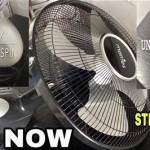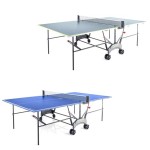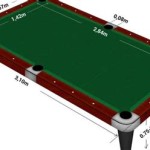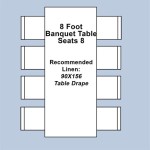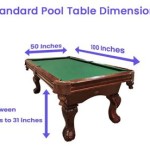Ping Pong Table Top Only: A Comprehensive Guide
A ping pong table top only, as the name suggests, refers to the surface of a ping pong table, excluding the frame, legs, and sometimes even the net and posts. This specialized product caters to individuals who already possess a suitable base or are seeking to repurpose an existing structure for table tennis. Understanding the nuances of these tabletops is crucial for selecting the best option to fulfill specific playing requirements and budgetary constraints.
The market offers a diverse range of ping pong table tops, varying in material, thickness, size, and features. This variety allows consumers to find a tabletop that aligns with their skill level, space limitations, and intended use. This article will delve into the key aspects of ping pong table tops only, providing a comprehensive overview of the features, materials, factors to consider, and maintenance necessary for making an informed purchase.
Key Considerations When Purchasing a Ping Pong Table Top Only
Several factors warrant careful consideration before acquiring a ping pong table top only. These considerations ensure the chosen tabletop aligns with the user's intended use, skill level, and existing infrastructure.
Material: The material of the tabletop significantly impacts its playability, durability, and price. The most common materials used are wood composites, like medium-density fiberboard (MDF) and particleboard. MDF is generally preferred due to its smoother surface and greater density, resulting in a more consistent bounce. Particleboard is a more economical option, but it can be less resistant to warping and damage. Some high-end tabletops may utilize solid wood or aluminum composites, offering superior performance and longevity but at a higher price point. The choice of material should be based on the desired level of performance and the budget available.
Thickness: The thickness of the tabletop is a critical determinant of bounce quality. Thicker surfaces generally provide a more consistent and predictable bounce, which is essential for competitive play. Regulation-sized ping pong tables typically have a thickness of 22mm or 25mm. However, for recreational use or limited space, thinner options, such as 16mm or 19mm, may be suitable. It is important to note that thinner tabletops may exhibit a less consistent bounce and may be more susceptible to warping over time. The intended use will dictate the appropriate thickness; serious players will usually prefer thicker options.
Size and Dimensions: Standard ping pong tables adhere to specific dimensions: 9 feet long, 5 feet wide, and 30 inches high. When purchasing a tabletop only, it is crucial to ensure that its dimensions match the standard specifications or are compatible with the existing base on which it will be placed. Deviations from these dimensions can negatively affect gameplay and lead to an uneven playing surface. Checking the precise measurements and comparing them to the intended support structure is essential.
Surface Finish: The surface finish of the tabletop also plays a crucial role in the quality of play. A smooth, even surface with a consistent matte finish is ideal. Glossy surfaces can cause glare, making it difficult to track the ball, while rough surfaces can impede the ball's trajectory. High-quality tabletops typically undergo a multi-layer painting process to achieve a consistent finish, followed by a clear coat for added protection. Examining the surface for imperfections and ensuring it adheres to standard color regulations (typically dark blue or green) is important.
Safety Features: While seemingly less relevant for a tabletop only, considering safety aspects is advantageous. Look for features like rounded edges to minimize the risk of injury, especially in environments with children. The weight of the tabletop and the stability of the support structure are also important safety considerations. Making sure the tabletop is securely attached to the base and that the base itself is stable is vital for preventing accidents.
Evaluating Tabletop Construction and Features
The construction of a ping pong table top, encompassing its internal structure and specific features, significantly influences its performance and longevity. A thorough evaluation of these aspects is paramount in selecting a suitable tabletop.
Internal Structure: The internal structure of the tabletop impacts its rigidity and resistance to warping. Some tabletops feature reinforced frames or cross braces underneath the playing surface. These reinforcements provide added support and prevent the tabletop from sagging or becoming uneven over time. High-quality tabletops might use a honeycomb or grid structure within the core to enhance stability. Assessing the internal structure, if possible, helps determine the tabletop's ability to withstand regular use and environmental changes.
Edge Banding: Edge banding is the material applied to the perimeter of the tabletop. It serves to protect the edges from damage and to provide a clean, finished look. High-quality edge banding is typically made of durable PVC or ABS plastic and is securely bonded to the tabletop. Weak or poorly applied edge banding can peel off over time, exposing the raw material underneath and compromising the tabletop's integrity. Examining the edge banding for its quality and adhesion is a key step in the evaluation process.
Net and Post Attachment Mechanism: While the "tabletop only" designation often implies the absence of a net and posts, some models may include a pre-installed attachment mechanism. If a net and posts are desired, the quality and design of this mechanism should be assessed. Look for sturdy clamps or screws that securely hold the net in place without damaging the tabletop. Adjustable mechanisms allow for fine-tuning the net height and ensuring it adheres to standard regulations. The availability of spare parts for the attachment mechanism should also be considered.
Folding Functionality: Some ping pong table tops are designed with folding capabilities, allowing for easy storage when not in use. This feature is particularly beneficial in environments where space is limited. If a folding tabletop is desired, the quality of the hinges and locking mechanisms is important. The hinges should be robust and able to withstand repeated folding and unfolding without weakening. The locking mechanisms should securely hold the tabletop in both the open and closed positions, preventing accidental collapses. Assessing the smoothness and stability of the folding mechanism is key.
Portability: The weight and ease of handling are also relevant considerations, especially if the tabletop needs to be moved frequently. Lighter tabletops are easier to transport and set up, but they may also be less durable. Features like built-in handles or carrying cases can greatly enhance portability. Considering the weight and dimensions of the tabletop in relation to the intended use and storage space is necessary.
Maintaining and Protecting Your Ping Pong Table Top
Proper maintenance and preventative measures are essential for preserving the condition and prolonging the lifespan of a ping pong table top. Regular cleaning and careful handling can prevent damage and maintain optimal playing performance.
Cleaning Procedures: Regular cleaning is crucial for removing dust, dirt, and other debris that can accumulate on the tabletop surface. Using a soft, damp cloth to wipe down the surface after each use is recommended. Avoid using harsh chemicals or abrasive cleaners, as these can damage the finish and affect the ball's bounce. Specialized ping pong table cleaners are available and are generally safe to use. Always follow the manufacturer's instructions when cleaning the tabletop.
Protection from Environmental Factors: Exposure to sunlight, humidity, and extreme temperatures can negatively impact the tabletop. Storing the ping pong table in a dry, climate-controlled environment is ideal. When not in use, covering the tabletop with a protective cover can shield it from dust, dirt, and UV radiation. Avoid placing heavy objects on the tabletop, as this can cause warping or dents. Taking precautions to protect the tabletop from environmental factors will significantly extend its lifespan.
Repairing Minor Damage: Minor scratches or dents can sometimes be repaired to prevent further damage. Small scratches can be filled with a paint touch-up kit that matches the color of the tabletop. Dents can sometimes be steamed or ironed out, although this requires caution and expertise. Consult with a professional if unsure about the proper repair techniques. Addressing minor damage promptly can prevent it from escalating into more significant issues.
Proper Storage Techniques: When storing the ping pong table top, ensure that it is placed on a flat, stable surface. Avoid leaning it against a wall or stacking other objects on top of it. If storing the tabletop in a vertical position, ensure that it is properly supported to prevent warping or damage. Storing the tabletop in its original packaging or a padded case can provide additional protection. Following proper storage techniques will help maintain the tabletop's integrity and prevent premature wear.
Regular Inspections: Periodically inspect the tabletop for any signs of damage, such as cracks, warping, or loose edge banding. Addressing these issues promptly can prevent them from becoming more severe and costly to repair. Regularly checking the net and post attachment mechanism for any signs of wear or looseness is also recommended. Routine inspections can help identify potential problems early on and ensure that the ping pong table top remains in optimal condition for years to come.

Buy Ping Pong Table Top W Accessories 19mm 274cmx152cm Mydeal

Md Sports Table Tennis Conversion Top Indoor Com

Md Sports Table Tennis Conversion Top Indoor Com

Erfly 9 X 5 Table Tennis Top Full Size

Table Top Only Billard

Ifs Table Tennis Top Only Sports Dynamix Rsa Za

Indoor Table Tennis Tables

Md Sports Table Tennis Conversion Top Indoor Com

Table Top Only Billard

Md Sports Table Tennis Conversion Top Indoor Com




